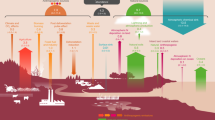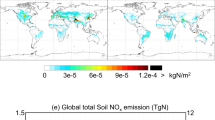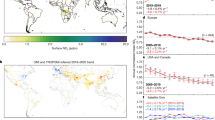Abstract
Nitrous oxide (N2O) is the third most important long-lived GHG and an important stratospheric ozone depleting substance. Agricultural practices and the use of N-fertilizers have greatly enhanced emissions of N2O. Here, we present estimates of N2O emissions determined from three global atmospheric inversion frameworks during the period 1998–2016. We find that global N2O emissions increased substantially from 2009 and at a faster rate than estimated by the IPCC emission factor approach. The regions of East Asia and South America made the largest contributions to the global increase. From the inversion-based emissions, we estimate a global emission factor of 2.3 ± 0.6%, which is significantly larger than the IPCC Tier-1 default for combined direct and indirect emissions of 1.375%. The larger emission factor and accelerating emission increase found from the inversions suggest that N2O emission may have a nonlinear response at global and regional scales with high levels of N-input.
This is a preview of subscription content, access via your institution
Access options
Access Nature and 54 other Nature Portfolio journals
Get Nature+, our best-value online-access subscription
$29.99 / 30 days
cancel any time
Subscribe to this journal
Receive 12 print issues and online access
$209.00 per year
only $17.42 per issue
Buy this article
- Purchase on Springer Link
- Instant access to full article PDF
Prices may be subject to local taxes which are calculated during checkout






Similar content being viewed by others
Data availability
Atmospheric observations used in the inversions are available from the databases indicated in the Acknowledgements. The atmospheric observations can be accessed from the WDCGG (https://gaw.kishou.go.jp), NOAA (https://www.esrl.noaa.gov/gmd/) and AGAGE (https://agage.mit.edu) websites. Precipitation and PDSI data are provided by the NOAA/OAR/ESRL PSD, USA, from their website at https://www.esrl.noaa.gov/psd/. Global statistics and data are available via FAO Statistics from the FAO. The CONTRAIL data used in the validation of the inversion results are available on request from H. Matsueda (MRI-JMA). The inversion output data are available from https://doi.org/10.5281/zenodo.3384591 and the N-data are available from https://doi.org/10.5281/zenodo.3384678. The inversion codes are available from the following authors on reasonable request: C.W. (c.wilson@leeds.ac.uk) for INV1; R.L.T. (rlt@nilu.no) for INV2; and P.K.P. (prabir@jamstec.go.jp) for INV3.
References
Ciais, P. et al. in Climate Change 2013: The Physical Science Basis (eds Stocker, T. F. et al.) Ch. 6 (IPCC, Cambridge Univ. Press, 2013).
Ravishankara, A. R., Daniel, J. S. & Portmann, R. W. Nitrous oxide (N2O): the dominant ozone-depleting substance emitted in the 21st century. Science 326, 123–125 (2009).
Park, S. et al. Trends and seasonal cycles in the isotopic composition of nitrous oxide since 1940. Nat. Geosci. 5, 261–265 (2012).
WMO Greenhouse Gas Bulletin No. 14 (WMO, 2018); https://library.wmo.int/doc_num.php?explnum_id=5455
Davidson, E. A. The contribution of manure and fertilizer nitrogen to atmospheric nitrous oxide since 1860. Nat. Geosci. 2, 659–662 (2009).
Bouwman, A. F. et al. Global trends and uncertainties in terrestrial denitrification and N2O emissions. Phil. Trans. R. Soc. B 368, 20130112 (2013).
Galloway, J. N. et al. The nitrogen cascade. BioScience 53, 341–356 (2003).
Bremner, J. M. Sources of nitrous oxide in soils. Nutrient Cycl. Agroecosyst. 49, 7–16 (1997).
Syakila, A. & Kroeze, C. The global nitrous oxide budget revisited. Greenh. Gas. Meas. Manage. 1, 17–26 (2011).
Tian, H. et al. Global soil N2O emissions since the pre-industrial era estimated by an ensemble of terrestrial biosphere models: magnitude, attribution and uncertainty. Glob. Change Biol. 25, 640–659 (2018).
IPPC: Summary for Policymakers. In Global Warming of 1.5 °C (eds Masson-Delmotte, V. et al.) (World Meteorological Organization, 2018).
Davidson, E. A., Suddick, E. C., Rice, C. W. & Prokopy, L. S. More food, low pollution (Mo Fo Lo Po): a grand challenge for the 21st century. J. Environ. Qual. 44, 305–307 (2015).
Springmann, M. et al. Options for keeping the food system within environmental limits. Nature 562, 519–525 (2018).
De Klein, C. et al. in IPCC Guidelines for National Greenhouse Gas Inventories, Prepared by the National Greenhouse Gas Inventories Programme Vol 4 (eds Eggleston, H. S. et al.) 1–54 (IPCC, IGES, 2006).
Crutzen, P. J., Mosier, A. R., Smith, K. A. & Winiwarter, W. N2O release from agro-biofuel production negates global warming reduction by replacing fossil fuels. Atmos. Chem. Phys. 8, 389–395 (2008).
Smith, K. A., Mosier, A. R., Crutzen, P. J. & Winiwarter, W. The role of N2O derived from crop-based biofuels, and from agriculture in general, in Earth’s climate. Phil. Trans. R. Soc. B 367, 1169–1174 (2012).
Shcherbak, I., Millar, N. & Robertson, G. P. Global meta-analysis of the nonlinear response of soil nitrous oxide (N2O) emissions to fertilizer nitrogen. Proc. Natl Acad. Sci. USA 111, 9199–9204 (2014).
Hoben, J. P. et al. Nonlinear nitrous oxide (N2O) response to nitrogen fertilizer in on-farm corn crops of the US Midwest. Glob. Change Biol. 17, 1140–1152 (2010).
Signor, D., Cerri, C. E. P. & Conant, R. N2O emissions due to nitrogen fertilizer applications in two regions of sugarcane cultivation in Brazil. Environ. Res. Lett. 8, 015013 (2013).
Song, X. et al. Nitrous oxide emissions increase exponentially when optimum nitrogen fertilizer rates are exceeded in the North China Plain. Environ. Sci. Technol. 52, 12504–12513 (2018).
Philibert, A., Loyce, C. & Makowski, D. Quantifying uncertainties in N2O emission due to N fertilizer application in cultivated areas. PLoS ONE 7, e50950 (2012).
Gerber, J. S. et al. Spatially explicit estimates of N2O emissions from croplands suggest climate mitigation opportunities from improved fertilizer management. Glob. Change Biol. 22, 3383–3394 (2016).
Saikawa, E. et al. Global and regional emissions estimates for N2O. Atmos. Chem. Phys. 14, 4617–4641 (2014).
Hirsch, A. I. et al. Inverse modeling estimates of the global nitrous oxide surface flux from 1998–2001. Glob. Biogeochem. Cycles 20, GB1008 (2006).
Huang, J. et al. Estimation of regional emissions of nitrous oxide from 1997 to 2005 using multinetwork measurements, a chemical transport model, and an inverse method. J. Geophys. Res. 113, D17313 (2008).
Prather, M. J. et al. Measuring and modeling the lifetime of nitrous oxide including its variability. J. Geophys. Res. Atmos. 120, 5693–5705 (2015).
Thompson, R. L. et al. Interannual variability in tropospheric nitrous oxide. Geophys. Res. Lett. 40, 4426–4431 (2013).
Ishijima, K., Nakazawa, T. & Aoki, S. Variations of atmospheric nitrous oxide concentration in the northern and western Pacific. Tellus B 61, 408–415 (2009).
Werner, C., Butterbach-Bahl, K., Haas, E., Hickler, T. & Kiese, R. A global inventory of N2O emissions from tropical rainforest soils using a detailed biogeochemical model. Glob. Biogeochem. Cycles 21, GB3010 (2007).
Nevison, C. D., Mahowald, N. M., Weiss, R. F. & Prinn, R. G. Interannual and seasonal variability in atmospheric N2O. Glob. Biogeochem. Cycles 21, GB3017 (2007).
Nevison, C. D. et al. Exploring causes of interannual variability in the seasonal cycles of tropospheric nitrous oxide. Atmos. Chem. Phys. 11, 3713–3730 (2011).
Lassaletta, L. et al. 50 year trends in nitrogen use efficiency of world cropping systems: the relationship between yield and nitrogen input to cropland. Environ. Res. Lett. 9, 105011 (2014).
Zhang, X. et al. Managing nitrogen for sustainable development. Nature 528, 51–59 (2015).
Winiwarter, W. et al. Technical opportunities to reduce global anthropogenic emissions of nitrous oxide. Environ. Res. Lett. 13, 014011 (2018).
Schneider, L., Lazarus, M. & Kollmuss, A. Industrial N 2O Projects Under the CDM: Adipic Acid—A Case of Carbon Leakage? Working Paper WP-US-1006 (Stockholm Environment Institute, 2010).
Meurer, K. H. E. et al. Direct nitrous oxide (N2O) fluxes from soils under different land use in Brazil—a critical review. Environ. Res. Lett. 11, 023001 (2016).
Jankowski, K. et al. Deep soils modify environmental consequences of increased nitrogen fertilizer use in intensifying Amazon agriculture. Sci. Rep. 8, 13478 (2018).
Pires, M. V., da Cuhna, D. A., de Matos Carlos, S. & Heil Costa, M. Nitrogen-use efficiency, nitrous oxide emissions, and cereal production in Brazil: current trends and forecasts. PLoS ONE 10, 1–20 (2015).
Herridge, D. F., Peoples, M. B. & Boddey, R. M. Global inputs of biological nitrogen fixation in agricultural systems. Plant Soil 311, 1–18 (2008).
Davidson, E. A. et al. The Amazon basin in transition. Nature 481, 321–328 (2012).
Zalles, V. et al. Near doubling of Brazil’s intensive row crop area since 2000. Proc. Natl Acad. Sci. USA 22, 428–435 (2018).
Merry, F. & Soares-Filho, B. Will intensification of beef production deliver conservation outcomes in the Brazilian Amazon? Elem. Sci. Anthrop. 5, 24 (2017).
Van Groenigen, J. W. et al. Towards an agronomic assessment of N2O emissions: a case study for arable crops. Eur. J. Soil Sci. 61, 903–913 (2010).
Firestone, M. K. in Agronomy Monograph 22: Nitrogen in Agricultural Systems 289–326 (American Society of Agronomy, Crop Science Society of America, Soil Science Society of America, 1982).
Firestone, M. K. & Davidson, E. A. in Exchange of Trace Gases Between Terrestrial Ecosystems and the Atmosphere (eds Andreae, M. O. & Schimel, D. S.) 7–21 (Wiley, 1989).
Kim, D.-G., Hernandez-Ramirez, G. & Giltrap, D. Linear and nonlinear dependency of direct nitrous oxide emissions on fertilizer nitrogen input: a meta-analysis. Agric. Ecosyst. Environ. 168, 53–65 (2013).
Adler, R. F. et al. The Version-2 Global Precipitation Climatology Project (GPCP) monthly precipitation analysis (1979–present). J. Hydrometeorol. 4, 1147–1167 (2003).
Dai, A. Characteristics and trends in various forms of the Palmer Drought Severity Index during 1900–2008. J. Geophys. Res. 116, D12115 (2011).
Tarantola, A. Inverse Problem Theory and Methods for Model Parameter Estimation (Society for Industrial and Applied Mathematics, 2005).
Thompson, R. L. et al. Nitrous oxide emissions 1999 to 2009 from a global atmospheric inversion. Atmos. Chem. Phys. 14, 1801–1817 (2014).
Wilson, C., Chipperfield, M. P., Gloor, M. & Chevallier, F. Development of a variational flux inversion system (INVICAT v1.0) using the TOMCAT chemical transport model. Geosci. Model Dev. 7, 2485–2500 (2014).
Fisher, M. & Courtier, P. Estimating the Covariances Matrices of Analysis and Forecast Error in Variational Data Assimilation Technical Memorandum No. 220 (European Centre for Medium-Range Weather Forecasts, 1995).
Patra, P. K. et al. Improved chemical tracer simulation by MIROC4.0-based atmospheric chemistry-transport model (MIROC4-ACTM). SOLA 14, 91–96 (2018).
Hall, B. D., Sutton, G. S. & Elkins, J. W. The NOAA nitrous oxide standard scale for atmospheric observations. J. Geophys. Res. 112, D09305 (2007).
Zaehle, S., Ciais, P., Friend, A. D. & Prieur, V. Carbon benefits of anthropogenic reactive nitrogen offset by nitrous oxide emissions. Nat. Geosci. 4, 601–605 (2011).
Suntharalingam, P. et al. Quantifying the impact of anthropogenic nitrogen deposition on oceanic nitrous oxide. Geophys. Res. Lett. 39, L07605 (2012).
Manizza, M., Keeling, R. F. & Nevison, C. D. On the processes controlling the seasonal cycles of the air–sea fluxes of O2 and N2O: a modelling study. Tellus B 64, 18429 (2012).
Anglade, J., Billen, G. & Garnier, J. Relationships for estimating N2 fixation in legumes: incidence for N balance of legume-based cropping systems in Europe. Ecosphere 6, 37 (2015).
Dentener, F. et al. Nitrogen and sulfur deposition on regional and global scales: a multimodel evaluation. Glob. Biogeochem. Cycles 20, GB4003 (2006).
Lassaletta, L. et al. Nitrogen use in the global food system: past trends and future trajectories of agronomic performance, pollution, trade, and dietary demand. Environ. Res. Lett. 11, 095007 (2016).
Stehfest, E et al. Integrated Assessment of Global Environmental Change with IMAGE 3.0. Model Description and Policy Applications (Netherlands Environmental Assessment Agency, 2014).
Le Noë, J., Billen, G. & Garnier, J. How the structure of agro-food systems shapes nitrogen, phosphorus, and carbon fluxes: the generalized representation of agro-food system applied at the regional scale in France. Sci. Total Environ. 586, 42–55 (2017).
Acknowledgements
We acknowledge the people and institutions who provided atmospheric observations of N2O that were used in the inversions or for validation, namely: E. Dlugokencky, G. Dutton, C. Sweeney (NOAA); J. Mühle (UCSD), P. Krummel, P. Fraser, L. P. Steele, R. Wang (CSIRO); S. O’Doherty, D. Young (Bristol University); Y. Tohjima, T. Machida (NIES); T. Laurila, J. Hatakka, T. Aalto (FMI); J. Moncrieff (University of Edinburgh); and H. Matsueda, Y. Sawa (MRI-JMA). AGAGE is supported principally by NASA (USA) grants to MIT and SIO, and also by BEIS (UK) and NOAA (USA) grants to Bristol University, CSIRO and BoM (Australia); FOEN grants to Empa (Switzerland), NILU (Norway), SNU (Korea), CMA (China), NIES (Japan) and Urbino University (Italy). We thank W. Feng (NCAS Leeds) for TOMCAT model support. L.L. is supported by MINEC-Spain and European Commission ERDF Ramón y Cajal grant (RYC-2016-20269), Programa Propio from UPM, and acknowledges the Comunidad de Madrid (Spain) and structural funds 2014-2020 (ERDF and ESF), project AGRISOST-CM S2018/BAA-4330. R.L.T. acknowledges financial support from VERIFY (grant no. 76810) funded by the European Commission under the H2020 programme, H.T. acknowledges support from OUC–AU Joint Center. P.K.P. is partly supported by the Environment Research and Technology Development Fund (no. 2-1802) of the Ministry of the Environment, Japan. The authors are grateful to G. Billen and J. Garnier for useful comments, and to the Food and Agriculture Organization of the United Nations.
Author information
Authors and Affiliations
Contributions
R.L.T. designed the study, contributed inversion results and prepared the manuscript. L.L. prepared the N-data and contributed to the manuscript. P.K.P., C.W. and M.P.C. contributed inversion results and to the manuscript. K.C.W., A.G., E.N.K., W.W. and E.A.D. helped with the analysis and contributed to the manuscript. H.T. and J.G.C. contributed to the manuscript.
Corresponding author
Ethics declarations
Competing interests
The authors declare no competing interests.
Additional information
Peer review information Nature Climate Change thanks David Makowski, Dave Reay and Iurii Shcherbak for their contribution to the peer review of this work.
Publisher’s note Springer Nature remains neutral with regard to jurisdictional claims in published maps and institutional affiliations.
Supplementary information
Supplementary Information
Supplementary Tables 1–5 and Figs. 1–11.
Rights and permissions
About this article
Cite this article
Thompson, R.L., Lassaletta, L., Patra, P.K. et al. Acceleration of global N2O emissions seen from two decades of atmospheric inversion. Nat. Clim. Chang. 9, 993–998 (2019). https://doi.org/10.1038/s41558-019-0613-7
Received:
Accepted:
Published:
Issue Date:
DOI: https://doi.org/10.1038/s41558-019-0613-7
This article is cited by
-
Cover crop residue decomposition triggered soil oxygen depletion and promoted nitrous oxide emissions
Scientific Reports (2024)
-
Intermediate soil acidification induces highest nitrous oxide emissions
Nature Communications (2024)
-
Warming Tends to Promote Nitrogen Conservation but Stimulate N2O Emissions in Mangrove Sediments
Ecosystems (2024)
-
Women's experiences and sustainable adaptation: a socio-ecological study of climate change in the Himalayas
Climatic Change (2024)
-
The interactive effect of temperature and fertilizer types determines the dominant microbes in nitrous oxide emissions and the dicyandiamide efficacy in a vegetable soil
Soil Ecology Letters (2024)



